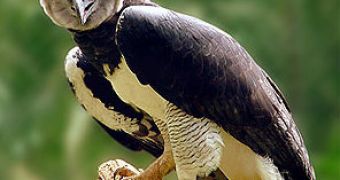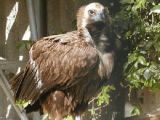Diurnal raptors or birds of prey are represented by falcons, eagles, vultures of the Old World, buzzards, hawks, harriers and related species. The vultures of the New World (condors included) are not real raptors but stork-related birds.
1. Raptors evolved 75-36 Ma ago, from chicken-like birds. The main trait of these predators is the presence of 2 foveas (highly sensitive areas) in the eye's retina (all other vertebrates, humans included, and most birds have just one). Unlike condors, these birds have weak olfactory sense.
Kites are the most primitive species, being less predatory, more sociable and lacking the sexual dimorphism. In raptors, males are usually smaller than females (even if they form monogamous pairs), as a smaller male is faster when hunting and providing the nesting female with food.
2. The back talon of the raptors is used for stabbing the prey. Those that prey on birds have longer talons. The talons can be 2 in (5 cm) long in larger species. The beak of the bald eagle can be 4,12 cm (1.6 in) wide, and 6.06 cm (2.4 in) long. The harpy eagle (Harpia harpyia) of the tropical Americas is considered the most powerful raptor. The female can weigh up to 9 kg (20 pounds) (the male is half her size) and can carry animals the same size.
The Eurasian black vulture (Aegypius monachus) is the world's largest raptor. The bird can be 1.1 m (3.7 ft) long, with a wingspan of 3.1 m (10.3 ft) and a weight of 12,5 kg (28 pounds). But, like all vultures, this is not an active hunter. Its claws are weak. The smallest raptor is the white fronted falconet (Microhierax latifrons): 15 cm (6 in) long, with a wingspan of 25 cm (10 in) and a weight of 35 grams.
3. Raptor birds have the most developed sight in the animal world. They can see objects of 20 cm (8 in) from a distance of 3,500 m (2.2 mi). A golden eagle has a sight 8 times sharper than that of a human. The tough expression of the prey birds is given by the superciliary arches protecting the eyes from air penetration at large speeds.
4. Falcons can be differentiated from other raptors by the presence of a tooth on the upper jaw used for tearing up flesh. The largest falcon is the gyrfalcon (Falco rusticolus) from the tundra: 62 cm (2 ft) long with a wingspan of 1.6 m (5.3 ft) and a weight of 2.1 kg (4.5 pounds) in females.
5. The peregrine falcon is considered the fastest raptor and bird. In active flight, it reaches 90 km (55 mi) per hour, but when diving the speed can reach 300 km (190 mi) per hour. The golden eagle (Aquila chrysaetos) can reach 190 km (125 mi) per hour when diving. In active flight, the fastest raptor is the Eurasian hobby (Falco subbuteo) which feeds on swallows and swifts.
6. Smaller species of raptors lay up to 7 eggs; larger species just one egg. The sparrowhawk can lay up to 12 eggs. The golden eagle can live 25 years in the wild and 46 in captivity. Sexual maturity is achieved in larger species (like the bald eagle) by the age of 7-8.
7. The osprey or fish eagle (Pandion haliaetus) is the only diurnal raptor that can make a catch holding two toes forward and two backward. The toes have spikes for securing the captured fish that can be 70 cm (2.3 ft) long. This species can submerge when catching fish, unlike the big fish eagles of the genus Haliaeetus (the bald eagle belongs to this group).
8. The Ruepell vulture (Gyps ruepelli) from the African savannas flies at altitudes of up to 10.800 m, a record amongst raptors.
9. Some raptors use tools, which stands as a testimony to their intelligence. The Egyptian vulture (Neophron percnopterus) breaks the shell of ostrich eggs using stones, while the bateleur (Terathopius ecaudatus) throws a stone when it sees its prey to scare animals out of their shelters.

 14 DAY TRIAL //
14 DAY TRIAL // 
